Wednesday 28 August 2013
Falkland Island Fox
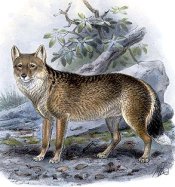
The
Falkland Island Fox is extinct. The scientific name of the Falkland Island Fox (Dusicyon australis) means "foolish dog of the south", referring to the absence of fear towards humans. This does not necessarily mean they are aggressive, it simply meant that were not able to comprehend how dangerous man could be to them. They were the sole predators at the island, and that was why maybe they were put into a false sense of security.
It was also known as "Warrah", the Falkland Island Fox was the sole land mammal of the Falkland Islands...and unfortunately, this animal turned extinct in 1876. Fur of the Falkland Island Fox possessed a brown-orange hue, but its tail was actually white. Food habits of these foxes were unknown. However, experts guess that since there were no native rodents at that place, the diet of the Falkland Island Foxes consists mostly of birds like penguins and grubs, and insects.
First sightings were in 1692 by Captain Strong. Around 1833 or thereabouts, settlers thought of this fox as a danger to the sheep, and out of fear, they set up massive shooting and poisoning. This extermination movement succeeded, and common sense dictates that this campaign was one major reason for the Falkland Island Foxes going extinct.
According to a few historical records, a Falkland Island Fox could get into a tent, and get a piece of meat from under the head of somebody sleeping. One manner described in these documents in the way of killing the foxes: hold out a piece of meat, and with the other hand, have a knife ready for the killing. In 1868, a live one was captured and taken to the London Zoo, but it did not live for a long time.
For more reading
Recently extinct animals
You can help spreading the word about this animal by liking it on facebook
Permanent Link
Monday 19 August 2013
Diademed Sifaka - One of the most colorful and attractive of all the lemurs
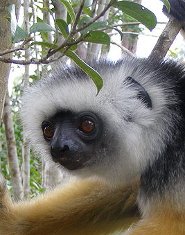
The
Diademed Sifaka (Propithecus diadema) is a species of lemur belonging to the Propithecus genus, known as sifakas. As are all lemurs, they are endemic to the island of Madagascar. Their range lies mostly within the lowland forests of eastern Madagascar and extends into the subhumid forests of the Central Highlands. The lowlands are made up of dense evergreen forests with canopies of up to 30 m (98 ft). The highlands are a more mountainous region covered in broadleaf forests. Males are 37.2-50.8 cm (14.6-20 in) in height and 3.04-6.5 kg (6.7-14.3 lb) in weight. Females are 37.2-53.5 cm (14.6-20 in) in height and 3.1-6.7 kg (6.83-14.8 lb) in weight. Sifakas are arboreal, rarely venturing out of trees. Their only terrestrial predators are the
fossa and the Nile crocodile. They may also be hunted by humans. It is considered taboo by many in Madagascar to hunt the sifaka, although much of the younger generation does not agree.
The Diademed Sifaka has a long, silky coat which is reddish-brown at the extremities and white to gray on the back and chest. The neck is black, as are the face and hands. The face is encircled by a white crown. Primatologist Russell Mittermeier called it "one of the most colorful and attractive of all the lemurs." Their diet consists of leaves, seeds, fruit and flowers. Traveling from tree to tree throughout the day, they consume as many as 25 species of vegetation. The Diademed Sifaka is a social animal, living in groups of 3-10. They scent-mark their territory, which they aggressively defend from other members of their species. They are known to tolerate the presence of other lemurs.
The Diademed Sifaka is an endangered species. It is classified by the International Union for Conservation of Nature as critically endangered. It is estimated to have a population of 6,000 to 10,000 individuals. The largest threat to this species is human destruction of its habitat; native peoples employ slash-and-burn farming techniques which destroy vast areas of forest. Much of this destruction takes place in national parks far from the populated areas of Madagascar's east coast, where laws protecting endangered species are difficult to enforce.
You can help spreading the word about this animal by liking it on facebook
Permanent Link
Wednesday 14 August 2013
Chamois - From Europe to New Zealand
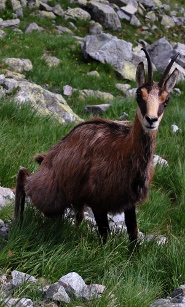
The
chamois (
Rupicapra rupicapra), is a goat-antelope species and native to the mountainous regions of Europe, the European Alps, the Carpathian Mountains of Romania, the Tatra Mountains, the Gran Sasso areas of the central Italian Apennines, the Balkans, the Caucasus, and parts of Turkey. The chamois is also found in the South Island of New Zealand, where they call it 'a shammy'. Since this species is on the verge of extinction, it is a protected animal under the "European Habitats Directive".
Chamois are normally found at higher altitudes and adapted to live in rugged, steep rocky terrain. A mature chamois may reach the height of about 30 inches (75 cm) and may weigh up to 110 lb (50 kg). Both, male and female have short and straight horns which turn backwards at the tip and males have more curved and longer horns than their counterparts. The horns of the chamois grow only in summer, no growth of the horns in winters. Because of this reason, a ring is formed on the horns every season which can give an indication of the chamois' age. The color of the coat changes according to the season and is dark brown in summers and turns light gray in winters.
The distinct characteristics of a chamois are its white face and the black strips below its eyes, a black strip on the back, and a white rump. Chamois can live up to 20 years of age. The adult males do not prefer living in herds; they choose to live in solitary while the young ones live in herds with their mothers. During the mating season (May in New Zealand, end of November or starting of December in Europe) there are fierce battles between the males to attract a female. The gestation period for impregnated female is 20 weeks long, and only one young one is born. The young chamois becomes an adult at the age of three years.
In 1907, the Austrian Emperor, Franz Joseph 1 had gifted an Alpine Chamois to New Zealand and this is how chamois got their entry in New Zealand. First, they were released in Mount Crook/Aoraki region and then, gradually, they spread all over South Island. There is no restriction on hunting of chamois in New Zealand and in fact, it is encouraged to minimize their impact on the New Zealand's alpine flora.
Chamois are hunted all over the world for their tasty meat. They come out in search of food when it is cool, i.e. in the morning and at night and this trait is exploited by the hunters because of which chamois become an easy target of hunting. The mane at the back of their neck is used to decorate hats in the alpine countries. Chamois are also killed for their smooth and soft leather.
Picture of the chamois by
Sfu, licensed under
GFDL
You can help spreading the word about this animal by liking it on facebook
Permanent Link
Friday 09 August 2013
The Alpine Ibex - Europe's greatest rock climber
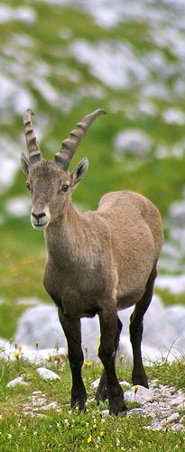
The
Alpine Ibex (Capra ibex) is a stocky member of the goat family that lives in mountainous areas of Europe, mainly in the Swiss Alps. The male ibex has magnificent curved horns that can measure up to 1 meter long. The horns of the male have very distinct ridges along the whole length. The male ibex also has a thick beard and a heavy coat that changes color from gray in the summer to brown in the winter. The female ibex has smaller smooth horns, but lacks the beard. Her coat does not change color with the seasons and remains a light brown color year round.
The male and female Alpine ibex are excellent climbers and have adapted to life in a mountainous rocky terrain. They roam at lower altitudes in search of food during the morning and evening hours. They are herbivores and they subsist on a diet of grasses, hay, woody plants, and leaves. During the daylight hours, they remain at higher altitudes to avoid predators. Their predators include bears, wolves, foxes, golden eagles, and
humans. In the wild, if they can avoid predators, Alpine ibexes have a lifespan of 10-14 years.
The Alpine ibexes live in groups, either in herds of females or bachelor groups of males. The males compete for the chance to join the herd of females during mating season. The males and females breed in the late fall, and their offspring, or kids, are born 5-6 months later. Females usually give birth to one offspring per year. Their offspring are natural rock climbers and are able to follow the females high up on the rocks only one day after birth. The young are mature at 8-12 months and will breed at 2-3 years of age.
The Alpine ibex was originally native to Italy but it almost became extinct in the early 19th century as a result of over-hunting. It was thought that the body parts of the ibex had magical powers. Conservation and re-introductions of the species in Switzerland, Austria, and France have increased their numbers and the ibex is not endangered at this time.
Picture of the Alpine ibex by Cash4alex, licensed under
Attribution-Share Alike 3.0 Unported
You can help spreading the word about this animal by liking it on facebook
Permanent Link
Wednesday 07 August 2013
The Desert Pocket Mouse - Don't Add Water
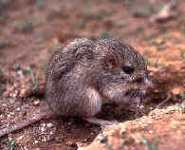
The
desert pocket mouse (
Chaetodipus penicillatus) lives in the desert regions of the southwestern United States, including Nevada, Arizona, parts of New Mexico, Texas and California, the Baja Peninsula and northeastern Mexico. It prefers dry, sandy regions with little vegetation. It's not generally found in rocky areas.
Common desert pocket mouse habitats include dry stream beds, desert washes or arroyos. The little vegetation around may consist of cacti, yucca, mesquite, palo verde or creosote bush.
The desert pocket mouse is a granivore, meaning seeds make up its diet. It burrows into the desert soil to find seeds from grasses or shrubs. It may occasionally supplement its diet with insects. The desert pocket mouse has cheek pouches to store seeds in, and it also builds burrows to store seeds for the winter. In some areas, the desert pocket mouse may go into partial
hibernation for the winter months, waking only often enough to eat stored seeds.
Interestingly, there's no evidence a desert pocket mouse drinks water. It seems to extract as much water as it needs from the seeds it eats. This helps it to live in an arid desert climate.
The average length of a desert pocket mouse is 180 millimeters, or seven inches. Of that length, more than half--about 110 millimeters--is its tail. Average weight varies from 11 to 22 grams, or .39 to .77 ounces. It has coarse fur that's grayish brown on its back and whitish on its underside. It has no lateral line or rump spines. Its feet are whitish, and its hind feet are about 25 millimeters long.
The desert pocket mouse has sharp front incisors that help it to break through hard, dry desert soil to search for buried seeds. They tend to be solitary animals who forage at night. They compete with other members of the Heteromyidae family for food. It has natural predators, such as owls, but is not currently in danger of extinction.
The average lifespan for a desert pocket mouse is just one year whether in the wild or in captivity. During that year, a female may bear one or two litters from early spring to late summer. On average, gestation takes 23 days and a litter consists of four young, though it could be as few as one or as many as seven.
You can help spreading the word about this animal by liking it on facebook
Permanent Link
Monday 05 August 2013
Guianan saki - Doing the Unexpected
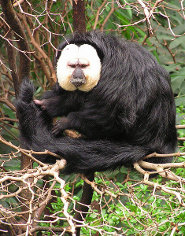
The
Guianan saki (Pithecia pithecia) or White-faced saki is one among several species of saki monkey from the New World. It is a small, shy monkey that rarely touches the ground and prefers a quiet family life. However, it can roar with power to protect its territory and leap through the air from tree to tree for up to 10 meters.
It lives with its lifelong mate in the understory and lower canopy of the rainforests in northern and central South America. It lives in Brazil, French Guiana, Guyana, Suriname, Venezuela and Peru. In its family group it communicates with twitters and shrill cries which are unique for each family, however, it can roar to warn other animals and saki monkey families away from its territory. The Guianan saki monkey does not swing through the trees by its tail, because it does not have a prehensile tail. It mainly walks on all fours but does stand on two feet to jump between branches.
Parents and offspring move together (called a federation) and protect their territory. They groom each other, which creates a bond in the family and often older siblings will care for the young ones. Adults weigh approximately 1.48 kg (3.256 lbs) and are 30 to 50 cm long (11.81 to 19.69 in). Their long, bushy tail doubles their size. They live up to 36 years.
The females mature earlier at a little over 2 years while the males mature at approximately 4 years. They have one offspring at a time, once a year. There is no season for mating, it happened throughout the year. The gestation is from 150 to 180 days. It is easy to tell the difference between the males and females. The males have black fur with, a reddish-white face and females have shorter hair with brownish-gray fur and light brown stripes around the nose and mouth. Their fur fringes around their foreheads and looks like little hoods.
They eat fruits, flowers, insects, leaves and nuts and spend much of the day resting. In Guiana, White-faced saki have been seen looking into tree hollows and collecting bats which they tear apart and eat. Eating and playing during the day, at night they curl up like cats and sleep in the tree branches. The biggest cat of the rainforest, the
jaguar, would prey on Guianan saki monkeys, but they are themselves endangered.
On the IUCN (International Union for the Conservation of Nature and Natural Resources) Red List of Threatened Species the Guianan saki monkey is classified as LC (Least Concern). Two recognized subspecies are
Pithecia pithecia pithecia and
Pithecia pithecia chrysocephala.
Picture of the guianan saki by
Skyscraper, licensed under
Creative Commons Attribution 3.0 Unported
You can help spreading the word about this animal by liking it on facebook
Permanent Link
 The Falkland Island Fox is extinct. The scientific name of the Falkland Island Fox (Dusicyon australis) means "foolish dog of the south", referring to the absence of fear towards humans. This does not necessarily mean they are aggressive, it simply meant that were not able to comprehend how dangerous man could be to them. They were the sole predators at the island, and that was why maybe they were put into a false sense of security.
The Falkland Island Fox is extinct. The scientific name of the Falkland Island Fox (Dusicyon australis) means "foolish dog of the south", referring to the absence of fear towards humans. This does not necessarily mean they are aggressive, it simply meant that were not able to comprehend how dangerous man could be to them. They were the sole predators at the island, and that was why maybe they were put into a false sense of security.
 The
The  The
The  The
The  The
The  The
The